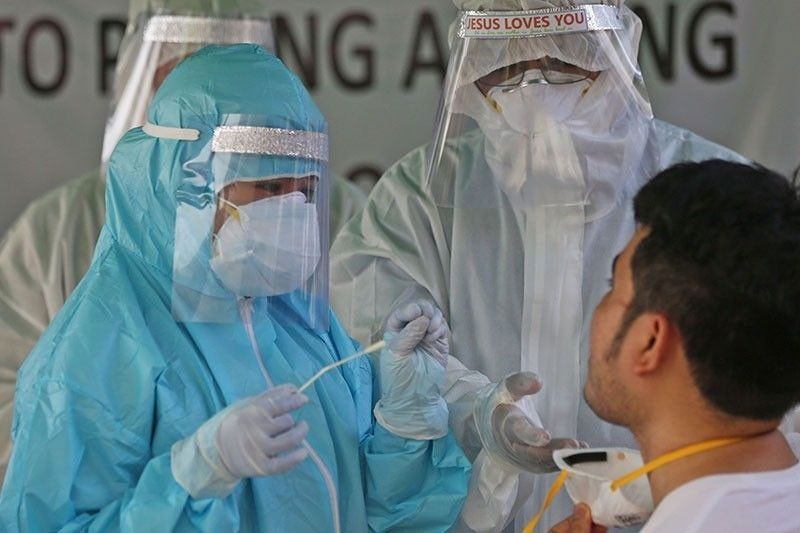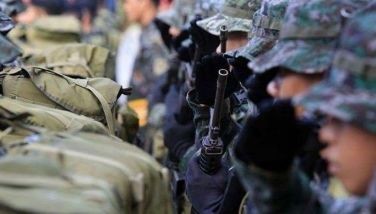WHO: Philippines COVID-19 cases rising fastest in region

MANILA, Philippines — The Philippines has the fastest increase in coronavirus disease 2019 or COVID-19 cases in the Western Pacific, according to the World Health Organization, prompting the Department of Health (DOH) to urge the WHO not to “cherry pick” countries for comparison.
Data from the WHO showed that the Philippines recorded a total of 8,143 new cases from June 16 to June 27 the highest among 22 countries in the region.
Singapore came in second with 2,351 new cases, followed by China with 302 in the same period.
The DOH yesterday recorded 653 more confirmed positive cases of COVID-19, bringing the country’s total to 35,455.
In its bulletin, eight more deaths and 258 new recoveries were recorded, bringing the totals to 1,244 and 9,686, respectively.
The DOH clarified the increase in COVID-19 cases in the Philippines, saying the comparison made with Singapore and other countries required a deeper understanding of population ratio versus number of cases.
The agency explained that Singapore has a population of only 5.9 million and a case load of 43,246, while the Philippines has 109 million people and 34,803 cases.
For every one million people, Singapore has a higher rate of 7,393 cases compared to the Philippines’ 318 cases, the DOH stressed.
While Singapore is able to manage its cases with a lower case fatality rate of 0.06 percent or 26 deaths per one million population, the Philippines registers a 3.6-percent CFR, or 1,236 per one million population, which is low compared with the global CFR of 5.1 percent.
Singapore has 4.4 deaths per million while the Philippines has 11.34 deaths per million.
“Our socioeconomic context, particularly living conditions, as well as health system capacity, even prior to COVID, is different from Singapore. Please take that into account when we do our analysis. Let us not cherry pick the countries we want to compare ourselves to,” the DOH said.
As the national government strives to manage COVID-19 in the absence of a cure or vaccine, the health department said all agencies are tasked to closely monitor the rise in cases and strengthen response through localized actions, especially in emerging hotspots.
Localized responses entail early detection of cases and tracing of contacts, their immediate isolation or quarantine, and appropriate testing and treatment.
“We have also addressed the rising critical care utilization through augmentation of equipment and workforce, and ensure that we can manage possible surges of cases,” the DOH said.
“We continue to emphasize the implementation of minimum health standards, like wearing of masks and physical distancing, as the most effective preventive measure in the absence of a vaccine,” it added.
‘Behavior change’
Despite the reported increase in the number of COVID-19 cases in the country, the health department gave assurance that the situation is not “hopeless” and “behavior change” can slow down transmission.
DOH Health Promotion and Communication Service director Beverly Lorraine Ho said the rise in COVID-19 cases is due to the increase in expanded testing and more mobility in various regions with the easing of quarantine restrictions.
“Should we be bothered? Yes. Should we become helpless? No. We know what each of us need to do as well as our local government units which should lead in the response,” Ho said in Filipino yesterday.
The DOH remains firm in instilling behavioral changes among individual Filipinos to become part of the solution in beating COVID-19.
“We would also like to remind everyone that having expanded testing does not mean we are all protected. Preventive behaviors and contact tracing efforts are still important. Let’s always give correct information whenever we register in public places and events so we can beef up our contact tracing efforts,” Ho said.
The National Capital Region has the most number of active cases, followed by Central Visayas, Calabarzon (Cavite, Laguna, Batangas, Rizal, Quezon), Central Luzon and Eastern Visayas.
There are also 1,779 active cases from repatriates.
Despite this, Ho noted that the country’s testing capacity has also increased.
“In May, our daily output played around 8,000-10,000, but this month, it has been hitting 16,000,” she said.
The DOH official attributed the increase to continuous community transmission and cited Cebu as an example.
“We can see this in Cebu, where the positivity rate is at 32.8 percent. It means that for every 100 tested, almost 33 persons are positive. This contrasts with the national positivity rate of seven percent,” she said.
‘Care for, not scare’
Sen. Francis Pangilinan yesterday prodded the government to “care for, not scare Filipinos” amid the COVID-19 pandemic after the WHO assessment.
Pangilinan said the alarming assessment was the WHO’s “diplomatic way of telling us that we in the Philippines is the worst” in the entire Western Pacific region.
“That’s where the Philippines stands out: the worst in responding to the pandemic,” he said in Filipino.
The assessment was embarrassing not only for the country’s neighbors, but also for Filipinos – particularly doctors, nurses and medical technologists – and more for all those who gave their lives, risking their safety to fight COVID-19 and trying hard to comply with the government’s “conflicting and confusing guidelines like easing restrictions without public transport,” according to the senator.
Pangilinan said he has been asking the government to intensify mass testing and contact tracing programs, and include the same in the measure proposed to replace the Bayanihan to Heal as One Act.
“(The pandemic) is not quelled by a show of force by the military or police or signature campaign for Cha-cha or federalism,” he said.
The senator lamented that the lockdowns, mass testing and contact tracing were not done simultaneously. He likened the campaign to combat COVID-19 to planting crops, where just watering or digging alone is enough.
“Giving care – that’s the essence of what every government should be doing, especially in a pandemic. Take care of the welfare of all, especially the vulnerable, poorest of the poor. Don’t ignore them. Don’t hurt them. Care for them,” he said.
Sen. Joel Villanueva also lamented the WHO findings, saying he has always said the government should be “conservative in its approach in reviving the economy,” and “the statistics are obviously consequences of these actions.”
“For the past weeks, we lost focus on our primary goal of containing the virus. We reopened the economy drastically, even for the non-essential sectors like (Philippine offshore gaming operators),” Villanueva said.
“We did not prohibit malls from extending their operating hours. We terminated social assistance, sent people back to work even without sufficient modes of public transportation. There was no clear guidance on surveillance and epidemiological monitoring,” he added.
The senator expressed hope during the past months that the government has upgraded the healthcare system to properly respond to this pandemic, as he encouraged the public to stay at home, practice social distancing and only come out of their homes when necessary.
“We urge the government to put in place a methodologically sound epidemiological surveillance so that we can make informed decisions on our policy approach regarding COVID-19,” Villanueva said.
DOST backs COVID-19 study
Meanwhile, the Department of Science and Technology (DOST) is backing a study that will look into how COVID-19 is transmitted from one person to another.
Science Secretary Fortunato dela Peña said the DOST is providing funding support for the research to be led by the Research Institute for Tropical Medicine (RITM) that will zero in on the people who have close contact with coronavirus patients at the RITM.
“We would like to utilize science to the fullest, particularly in coping with the prevention and control of the viral infection,” Dela Peña told The STAR.
“We support the RITM in their research activities as their mandate defines,” he added.
The science chief said the study would determine the transmission of the disease to help improve and guide efforts to understand its transmission and prevent its further spread.
He added that the disease’s transmission pattern and severity study would help in its characterization, spectrum and impact on the community.
The information to be gathered in the research will serve as a guide in formulating guidelines for case isolation, contact tracing, and disease control and prevention.
The project, which received a P4.985-million grant from the DOST-Philippine Council for Health Research and Development, is expected to yield data that will describe the transmission dynamics which will include clinical presentation and course of the disease, secondary infection rate, clinical attack rate among close contacts and symptomatic proportion of COVID-19 cases.
Data that will be generated from the study will be shared with the DOH to help in crafting policies that will improve its strategy in preventing and containing the disease. Paolo Romero, Rainier Allan Ronda, Delon Porcalla, Rudy Santos
- Latest
- Trending


























